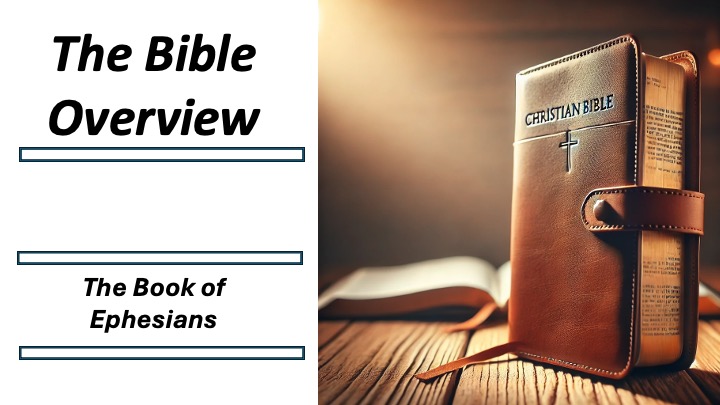Bible Overview Ephesians
Mike Ervin

EPHESIANS STUDY OVERVIEW
1. AUTHORSHIP AND DATE
Traditional View:
• Authorship:
Ephesians is traditionally attributed to the Apostle Paul. The letter opens
with “Paul, an apostle of Christ Jesus” (Eph. 1:1), and early church tradition
uniformly affirms his authorship.
• Date:
It is commonly dated to A.D. 60–62, during Paul’s imprisonment (likely in Rome
or Caesarea), which fits its reflective and pastoral tone.
Modern Scholarly View:
• Authorship:
While most scholars continue to support Pauline authorship, many note
differences in vocabulary and style compared to Paul’s undisputed letters
(e.g., Romans and 1 Corinthians). This has led some to propose that Ephesians
may have been revised or edited by a follower within the Pauline circle.
• Date:
Modern scholarship still generally places the letter in the late first
century—around A.D. 60–62—based on internal evidence and its theological
themes.
cite
2. INTENDED AUDIENCE
Traditional Interpretation:
• The letter is addressed “to the saints who are in Ephesus” (Eph. 1:1),
indicating that the primary audience was the Christian community in Ephesus, a
major urban center in Asia Minor.
Modern Interpretation:
• Many modern scholars suggest that while Ephesus is mentioned, the letter’s
themes are broad enough to indicate that it may have been a circular letter
intended for several churches in the region. Its emphasis on the cosmic nature
of the gospel and the unity of believers implies that its message was meant to
resonate beyond a single local congregation.
cite
3. MAJOR THEMES
1. The Mystery of the Gospel and Divine Blessings:
• Traditional: Paul emphasizes the manifold spiritual blessings in Christ—such
as election, predestination, and adoption (Eph. 1)—presenting salvation as a
gracious act of God.
• Modern: Scholars highlight that the “mystery” in Ephesians reveals God’s plan
to unite Jews and Gentiles into one body, a concept with cosmic and
ecclesiological significance.
2. Unity of the Church:
• Traditional: The church is portrayed as the body of Christ, called to unity,
mutual edification, and to reflect Christ’s reconciling work (Eph. 4).
• Modern: Modern readings emphasize that this unity transcends ethnic and
cultural divisions and has implications for a global, multi-ethnic church.
3. Ethical Exhortation and New Life in Christ:
• Traditional: Believers are urged to live lives worthy of their
calling—abandoning their old selves and embodying love, purity, and humility
(Eph. 4–5).
• Modern: Contemporary scholars view these instructions as both the natural
outgrowth of theological truth and as practical guidelines for living in a
diverse and complex world.
4. Spiritual Warfare:
• Traditional: The final chapter vividly portrays the reality of spiritual
conflict and exhorts believers to “put on the whole armor of God” (Eph. 6).
• Modern: This theme is interpreted both as a metaphor for the internal
struggle against sin and as a depiction of the active resistance of evil forces
in the world.
cite
4. SEQUENTIAL REVIEW OF THE TEXT
Ephesians is composed of six chapters that naturally divide into two major
sections:
I. Theological Exposition (Chapters 1–3):
• Chapter 1:
• Content: Paul opens with a doxology praising God’s spiritual blessings in
Christ (election, adoption, redemption).
• Key Focus: Establishes the theological foundation of God’s redemptive plan.
• Chapter 2:
• Content: Explores the transition from spiritual death to life—emphasizing
that salvation is by grace through faith, not by works—and highlights the
reconciliation between Jews and Gentiles.
• Key Focus: The transformative power of God’s grace breaking down ethnic and
cultural barriers.
• Chapter 3:
• Content: Paul unveils the “mystery” of the gospel—that Gentiles are fellow
heirs with Israel—and prays for the believers’ spiritual strength.
• Key Focus: The unity and inclusivity of God’s plan in Christ.
II. Ethical Exhortations and Practical Instructions (Chapters 4–6):
• Chapter 4:
• Content: Paul calls for unity in the body of Christ, urging believers to live
in humility, gentleness, and love, and to use their spiritual gifts for the
edification of the church.
• Key Focus: Maturity in the faith and the communal identity of the church.
• Chapter 5:
• Content: Offers practical instructions on how Christians should
live—highlighting love, purity, and wisdom. Paul also uses the marital
relationship as a metaphor for Christ’s relationship with the church.
• Key Focus: Living out one’s new identity in Christ through ethical behavior
and loving relationships.
• Chapter 6:
• Content: Concludes with further exhortations, including a strong call to
spiritual vigilance through the imagery of the “armor of God.”
• Key Focus: Equipping believers for spiritual battle in their daily lives.
cite
5. CONCLUSION
• Traditional Perspective:
Ephesians remains a foundational text that teaches the profound mystery of
God’s redemptive work—emphasizing unity in Christ, the church’s identity, and
ethical living in light of divine grace.
• Modern Perspective:
Scholars appreciate Ephesians for its rich theological vision, particularly its
cosmic scope and its emphasis on reconciling divisions among peoples. Even when
questions about its editorial history arise, its message of unity and
transformation continues to influence contemporary Christian thought.
• Practical Implication:
For today’s believers, Ephesians challenges them to embrace their identity as
members of a united body in Christ, live out ethical exhortations in a
fragmented world, and remain vigilant in the face of spiritual challenges.